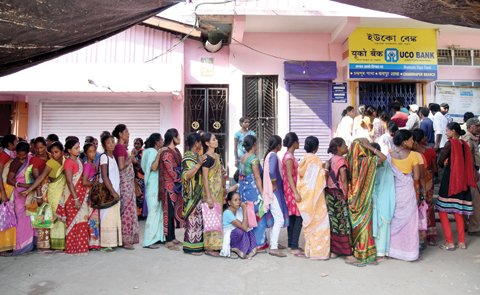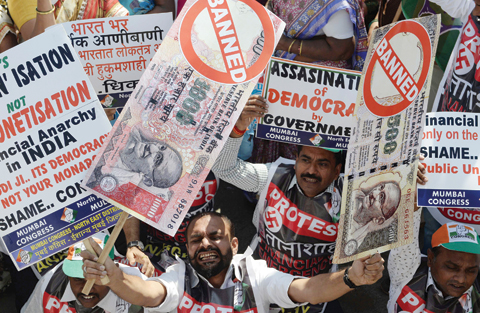 File Photo: GUWAHATI: Indian villagers wait in a queue outside a bank to deposit and exchange 500 and 1000 rupee notes in Chandrapur Village, some 30 km from Guwahati yesterday. — AFP
File Photo: GUWAHATI: Indian villagers wait in a queue outside a bank to deposit and exchange 500 and 1000 rupee notes in Chandrapur Village, some 30 km from Guwahati yesterday. — AFPMUMBAI: Indians returned almost the entire amount of currency withdrawn in the government's note ban of Nov 2016, raising fresh questions over the purpose of a shock move that triggered a sharp slowdown in the economy. In its annual report, the Reserve Bank of India said the total value of notes returned by the public was 15.3 trillion rupees ($216.7 billion) or 99.3 percent of the total of 15.4 trillion rupees of notes in circulation on Nov 8, 2016. "The figures show the demonetization exercise was a flop," said a chief economist at a bank, who sought anonymity as the subject is a sensitive one. "Almost the entire amount came back, which showed that people were not hoarding money in cash."
Prime Minister Narendra Modi stunned India with his so-called demonetization campaign that he said aimed to uncover unaccounted wealth and counterfeit money. The old notes of 500-rupee and 1,000-rupee denomination ceased to be legal tender from Dec 31, 2016. The move hit India's growth, driving it to a three-year low of 5.7 percent in the June quarter of 2017, with several small businesses shutting down and many laborers losing their jobs.
However, Subhash Chandra Garg, the government's economic affairs secretary, told reporters the RBI data did not mean the effort was unsuccessful. "I think demonetization achieved its objective quite substantially," Garg said, declining to elaborate. "Let's not enter into debate on this issue." The RBI also highlighted the upside risks to inflation from global crude oil prices strengthening expectations of another rate hike. India's July inflation rose an annual 4.17 percent, the ninth straight month in which it surpassed the RBI's medium-term target of 4 percent. The upside risks to inflation in the rest of the year warrant a "continuous vigil and a readiness to head off those pressures from getting generalized", the central bank added.
Meanwhile, the Indian rupee hit fresh lows against the dollar yesterday as emerging market currencies continue to be sold off. The under-pressure currency in Asia's third-largest economy slid to 70.50 to the greenback in late morning trade, a record low. The rupee has been steadily falling throughout 2018 after starting the year at 63.67. Earlier this month it crossed 70 for the first time as India was buffeted by the turbulence of the Turkish financial crisis. The rupee was not alone, with the currencies of other emerging economies heavily dependent on dollar-dominated foreign capital like Brazil, South Africa, Argentina and Brazil also slipping in August.
The rupee slump is widening India's current account deficit, when the value of imports exceeds that of exports. India is a massive net importer of oil, securing more than two-thirds of its needs from abroad. High oil prices have been squeezing the rupee, making it less appealing to investors, analysts say. India's central bank has raised interest rates this year in part to help increase the value of the rupee. - Agencies











